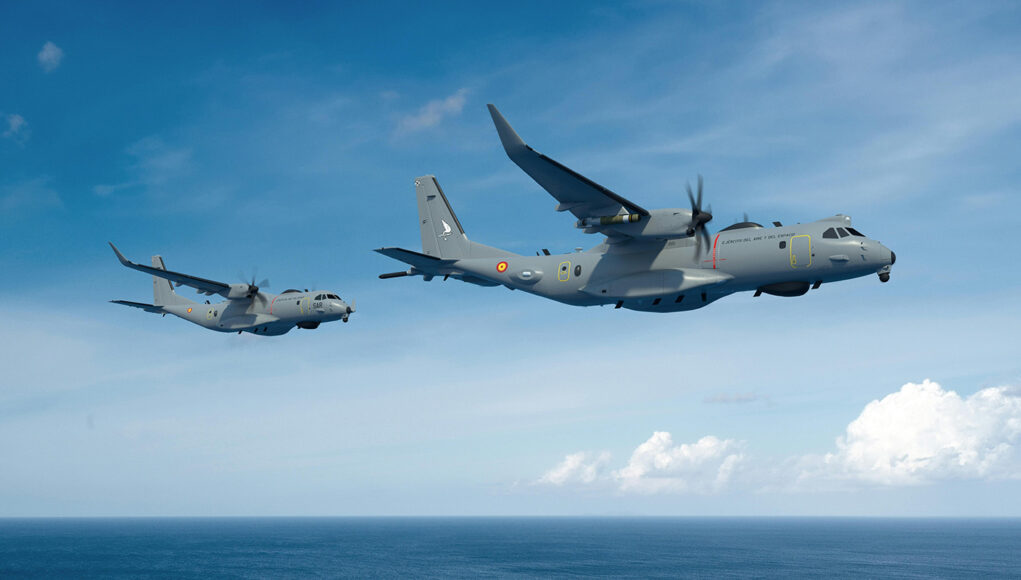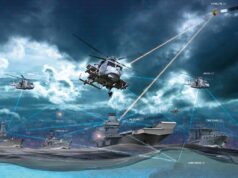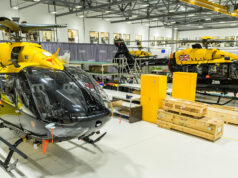The Spanish Ministry of Defence has ordered 16 Airbus C295 aircraft in Maritime Patrol Aircraft (MPA) configuration and Maritime Surveillance Aircraft (MSA) configuration.
The contract amounts to €1.695 billion.
These new aircraft will enable the Spanish Air and Space Force and the Spanish Navy to strengthen the national anti-submarine warfare capability as well as increase and enhance its surveillance, reconnaissance and search & rescue units.
“The aircraft will be fully designed and manufactured in Spain, fostering the national industrial defence footprint and sovereignty” said Mike Schoellhorn, CEO of Airbus Defence and Space.
“In particular, the Maritime Patrol version is the most complex C295 mission configuration to date. A major development project that will bring together the latest technologies to provide an operational advantage to our customer.”
The contract also includes training systems (Full Flight Simulator and Mission System Simulator) and an initial logistics support package.
“The C295 MPA will conduct the missions performed by the P-3 Orion fleet, which were retired at the end of 2022. It will be equipped to carry out anti-submarine, anti-surface warfare and intelligence, surveillance and reconnaissance missions. Likewise, it will be able to carry armaments such as torpedoes and other types of weapon systems. The MPA configuration will be highly connected and will be able to operate in a collaborative mode with other platforms in different domains. The aircraft can become a flying command-and-control centre, providing the Spanish Armed Forces with the versatility to carry out a wide range of missions.
The C295 MSA is the natural replacement for the CN-235 VIGMA aircraft fleet, which have been in service with the Spanish Air and Space Force since 2008. It will be primarily equipped for maritime and overland operations such as anti-smuggling, anti-illegal immigration and anti-drug trafficking operations, as well as national and international search-and-rescue missions. There will be a high degree of synergy between both configurations. The Spanish Air and Space Force also operates a fleet of 13 Airbus C295 in transport configuration.”
The aircraft will be assembled at Airbus’ military facilities in Seville.














Believe that they are split 6 MPA and 10 MSA. As Spain has such a large maritime area it is responsible for would have thought that a 8/8 or 9/7 split would have been better?
Given the bit about it being “the most complex configuration” for the 295, and “a major development project”, could be a cost/time issue driving the split?
Yes, would imagine that costs are a major driving force, much like our decision to reduce our Wedgetail numbers from 5 to 3.
There aren’t many actors with a SMs left in the Med, so perhaps they have got the split right for their needs?
Sorry, should say ‘non NATO’ actors with modern SMs.
I wish some additional funds could be found for a further 5-6 more Poseidon MPAs for the RAF.
RAF/RN should not procure anymore of the Boeing 737-800 based Poseidon MPAs. The airframe is obsolete and the UK should rather look to purchase the better and more modern Japanese Kawaski P1 platform. Acquisition of the better Japanese platform will also strengthen UK/Japan relationships, especially with current ongoing GCAP fighter and missile program and bring the UK a platform that it can more readily customize for its own use rather than the American P8 Poseidon which is being offered essentially as take it or leave it product.
Does the RAF have the budget to bring an entirely new line of aircraft online with all the costs? If there was to be any MPA increase it would be P8s.
I agree, we should have gone for the P1 from the outset, for some of the very reasons you mention. Unfortunately that ship has long sailed, as @Mark posts, any money for mote MPAs will go towards P8s.
Genuinely curious to know why you consider the P8 to be obselete? As far as I have seen it has the most advanced set of sensors, the largest user base and easily the most capable mpa when it comes to its list of weapons that it can/will carry.
I think they mean the 737 800 is not longer in production and alothough a civil airframe it likely to go out of service with airlines sooner as they tend to replace airframes faster than the military meaning cost of maintaining a diminishing number of ariframes increases.
However the costs now are probably lower given the number of 737 800s in service so we should consider the through life costs not just what it may cost in say10 years time.
The real shame of MPA procurement was not selecting an Airbus airframe instead of a defunct Comet airframe, had we done this we could have been a major exporter of MPA/s
The airframe it’s based on, not the kit on-board.
Using a “newer” airframe is not the only metric used when trying to figure out which aircraft is more capable mpa.
I know it isn’t, I was answering the question you asked of why the P8 would be considered obsolete.
I don’t think it’s an obsolete piece of kit, I’d be buying more if I was the one in charge of the purse strings.
He said the airframe is obsolete. Not the aircraft. As in 737 is an old design and the 800 model has already been replaced. The 737 was designed in the 1960s and was based on a lot of the 707 which is a 1950s design.
It’s nothing to do with what’s in the the airframe. The P1 was designed to be a MPA from the beginning where as the P8 wasn’t.
“He said the airframe is obsolete. Not the aircraft. As in 737 is an old design and the 800 model has already been replaced”
Not a very convincing argument to be honest. Both of these aircraft came into service around the same time, the P8 actually a little newer and the argument can be made that the P8 is based on the most common commercial aircraft ever built which should be a huge benefit when it comes to through life cost. Now in terms of capabilities I agree that a aircraft built from the ground up as a mpa should have some advantages but again the argument is made that the P-1 is based off older mpa tactics and ideas and the sensors and weapons that the P8 brings to the discussion overcomes any disadvantages of the base platform.
Hi mate, I dont consider the P-8 obsolete, just not the best choice of air frame for the job.
The P1 is a purpose designed MPA, able to operate across a range of altitudes, but more importantly low down in the weeds, less then 1000 ft with no issues. It has a greater range and payload capacity than the P-8, which is arguably a positive capability.
The P-8 is a converted airliner designed to fly at altitude,25000 ft or more, so doesn’t really like being down low in the thicker air. Not saying it cant operate down there, but its not designed to. Hence the need for a glide kit to effectively launch torpedoes.
Generally speaking, the lower you are the more accurate you are able to get your weapon/sensors (sonar buoys) onto the target.
Its undoubtedly got a good sensor outfit, but you can buy/design that and put it any air frame.
Yes, on cost grounds it makes sense cant/wont argue with that, but, its a compromise, there are/is a better option available when both aircraft were looked at by the RAF prior to selection of said P8. We wont go anywhere else now, it would be foolish and uber expensive to do so, I just dont think we went for the right option from the start, we chose cost over capability imo.
Thank you for your great response as I know you’re more familiar than most about this topic. I get the impression from the P-8 supporters that they believe the advancement in tech makes the “traditional” down low way of sub hunting increasingly unnecessary and they are able to find and prosecute targets from a higher altitude. I certainly get the skepticism about this point of view but based on the numbers procured from several countries, there might be some truth to it.
No worries mate, always good to get into discussions about issues on this site.
Further to your post above, its not the advancement in ‘tech’ that necessitates a change in the way P-8s need to operate (ie higher up, MPA’s have always had that ability), its more to do with the fact that the aircraft isnt designed to operate at low level. That is all down to the design and shape of the wing.
If you look at all the MPA designs since the war, both land based and carrier based, they all broadly have one thing in common – a straight thick unswept wing. Structurally very strong when compared with an aircraft that is designed to operate at altitude.
Carrier based aircraft – Gannets, Trackers, Vikings etc wings were all short fat and straight. Land based MPAs whether converted airliners (P3/Nimrod) or purpose built – French Atlantique were very similar only longer/broader, but still thick. It is this aspect that allows the aircraft to operate in the thicker/denser air at low altitudes, something which said P-8s dont like.
All the previous land based aircraft had a MAD boom as another detection sensor, weo the Indian Navy P-8s this capability isnt fitted to any other P-8s. Using MAD is a low level game generally the lower the better. To compensate for the lack of a MAD boom, Boeing have developed a drone controlled by the aircraft for customers who still want this capability. Don’t believe that we purchased that option though. Hope this helps.
I second that P1 buy. It was a natural replacement for the nimrod in the way it operates. The Japanese would perhaps of been more accommodating to RAF specific kit.
Now with closer relationship with Japan it would have been a great choice. Hindsight’s a wonderful thing as they say.
The uk could have acted as aircraft salesman for the P1.
Ive always thought that we should have gone down the P-1 route when we decided to get back into the MPA game. Capability wise its a superior package just more expensive I imagine. Agree that it was probably a missed opportunity at closer collaboration with the Japanese from an earlier perspective.
On the plus side, at least we are now back in the MPA game, although with fewer assets then we ideally require – 6 more wouldn’t go amiss!!!
Didn’t the Japanese put the P1 forward back in 2015? Should have gone for it for sure.
Guessing someone got a decent back hander for more work and money being driven into Boeing.
Corruption in DE&S is commendably rare.
There are thousands of 737-800 out there, whilst they may not be the most modern frame they will be cheap and easy to maintain and get parts for decades to come.
However I think the money should first go towards buying more wedgetails, as they will be heavily needed for both home defence and also support in any overseas deployment.
Might be wrong but we have/had the kit for for the 5 Wedgetails that we were contractually obliged to buy but not the airframes to put it in, to save money. As I said, might be wrong if someone knows more?
This is correct. Assuming try don’t get sold off for next to nothing, then there is hope that one day they might be used should the money be found.
More wedgetails would be nice.
After Nimrod and Ajax our cupboard bare. I hope those responsible are living in penury. If not why not?
Given the order book for the 295 I wonder when they will come into service?
Did they contact Bombardier before selection?
Spain at least has final production of airframes, sadly the UK will no longer have this capabilty in less than 2 years. Although I hear Britian Norman have repratriated some production but its hardly of the complexity we need to be a serious contender.
Depends.
If you are talking Gen6 aircraft that is more like Formula One car production than blokes riveting panels.
That is mostly autoclave based manufacturing.
So traditional aircraft fuselage techniques are sunset.
We still make all the difficult bits like the wings and the hard bits of Typhoon in the UK.
The UK didn’t produce a commercial aircraft between BAE146 ending production two decades ago, and Britten Norman repatriating manufacturing a year or two ago (if you count them).
Comparing Typhoon to a commercial aircraft is comparing apples and oranges. BAE can’t develop a commercial aircraft no matter how many Typhoons they make, just like Britten Norman or Yeovil can’t develop a fast jet no matter how many Islanders or Merlins they make.
They need to replace the Orion. Given it is assembled in Spain it is a good political move. Commonality of type makes sense. I do wonder if it is also linked to a possible reduction in A400 build. A kind of sweetener for a forthcoming bitter pill. The bulk of the remaining A400 orders are for three countries. Not sure if quite a few of them maybe cancelled myself.
Big deal. Meanwhile our clueless politicos let our useful civil aviation industry wither and die.
The Spanish and the rest of club Med have given little or nothing to Ukraine. Shame on them!
Spain and club med have actually given more funding in gdp value through the EU than the U.K has. Spain is at 0.7% of gdp while the U.K. is at 0.45%
What each nation has given is fairly easily searchable you know….
Have noticed that their MPA version as shown in the above picture, has a MAD tail. Whereas our P8 Poseidon does not. Be interesting to know the reasons why the RAF decided that this sensor wasn’t worth having? As I see the Indian version of the P8 has included the MAD tail.